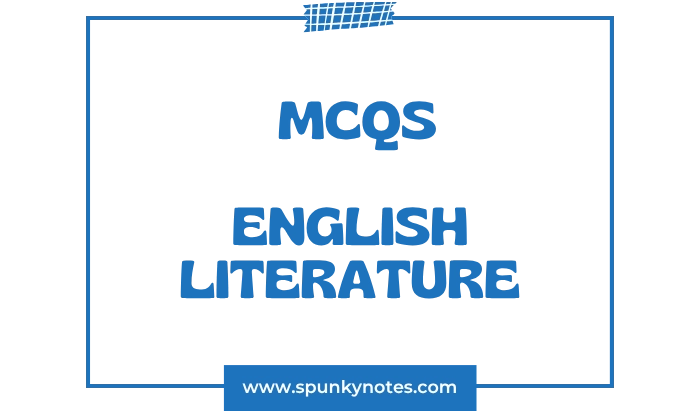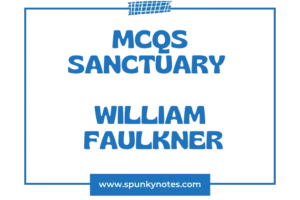

Estimated Reading Time: 16 min
English Literature MCQs
1. Troilus and Criseyde is a medieval poem written by:
A. John Gower
B. William Langland
C. Geoffrey Chaucer.
D. Richard Rolle of Hampole
2. Everyman is the name of:
A. a morality play
B. a miracle play
C. a sermon
D. a ballad
3. The Shakespearean or English Sonnet was introduced by:
A. Surrey
B. Wyatt
C. Shakespeare
D. Sidney
4. “Her voice was ever low and gentle, an excellent thing in a woman” are words spoken of:
A. Cleopatra
B. Rosalind
C. Cordelia
D. Ophelia
5. Of the following plays by Shakespeare, the latest in date is:
A. The Tempest
B. Measure for Measure
C. King Lear
D. Troilus and Cressida
6. ‘Areopagitica’, a prose work by Milton, is a passionate plea against :
A. Censorship of books
B. Abolition of the Monarchy
C. Retention of the Monarchy
D. Civil War
7. When were the theatres closed down in England?
A. 1652
B. 1562
C. 1542
D. 1642
8. Dryden’s Absalom and Achitophel is based on a story from
A. Boccaccio’s Decameron
B. Homer’s Iliad
C. The Old Testament in the Bible
D. Chaucer’s Canterbury Tales
9. Which of the following is not a Metaphysical Poet?
A. Andrew Marvell
B. John Donne
C. Richard Lovelace
D. George Herbert
10. ‘The Flea’ is a poem by:
A. George Herbert
B. John Donne
C. Andrew Marvell
D. Henry Vaughan
11. Belinda appears in:
A. The Rape of the Lock
B. The Rape of Lucrece
C. Hero and Leander
D. London
12. Sophia Western is a character from:
A. Joseph Andrews
B. Pamela
C. Tristram Shandy
D. Tom Jones
13. Of which 18th-century writer did Dr Samuel Johnson say, “He wrote like an angel but talked like poor Poll”?
A. Richard Sheridan
B. Joseph Addison
C. Oliver Goldsmith
D. Richard Steele
14. Thomas Hardy borrowed the title of his novel Far From the Madding Crowd from:
A. ‘Elegy Written in a Country Churchyard’
B. ‘Ode to Evening’
C. ‘The Seasons’
D. ‘The Progress of Poesie’
15. Of the following, who can be described as a man of sentiment?
A. Charles Surface
B. Oliver Surface
C. Joseph Surface
D. Sir Peter Teazle
16. Who followed Wordsworth as the poet laureate?
A. Robert Bridges
B. Alfred Austin
C. Tennyson
D. W. H. Auden
17. Jane Austen’s novels were written during the:
A. Anglo-Dutch naval encounters
B. Hundred years war
C. Wars of the Roses
D. Napoleonic wars
18. With whom is the phrase ‘Negative Capability’ associated?
A. Keats
B. Blake
C. Byron
D. Shelley
19. Which of the following is not written by Charles Lamb?
A. A Dream Children
B. Old and New Schoolmasters
C. Selected Snobberies
D. Valentine’s Day
20. The poem by Keats in which an allusion to Ruth occurs is:
A. ‘Ode to Autumn’
B. ‘Ode to a Nightingale’
C. ‘Ode to Psyche’
D. ‘Ode on a Grecian Urn’
21. The major trait of Arnold’s temperament as evident in his poetry is:
A. Optimism
B. Courage
C. Melancholy
D. Gaiety
22. Who wrote The Picture of Dorian Gray?
A. Thomas Hardy
B. Thackery
C. Oscar Wilde
D. Jane Austen
23. Who wrote Jane Eyre?
A. Mrs. Gaskell
B. Emily Bronté
C. Anne Brontë
D. Charlotte Brontë
24. What is the fictional name of Mary Ann Evans?
A. Charlotte Bronte
B. George Eliot
C. Emily Bronte
D. Jane Austen
25. To which literary school did William Morris belong?
A. Georgian
B. Imagist
C. Pre-Raphaelite
D. Oxford Movement
26. A work by an English writer articulating feminist concerns in the twentieth century is:
A. A Room with a View
B. A View from the Bridge
C. A Room of One’s Own
D. Jacob’s Room
27. Adela Quested is a character in a novel by:
A. Virginia Woolf
B. E.M. Forster
C. James Joyce
D. Paul Scott
28. The French Symbolist poet who exercised the greatest influence on T. S. Eliot was:
A. Mallarme
B. La Forgue
C. Bandelaire
D. Verlaine
29. Which of the following is not written by D. H. Lawrence?
A. Sons and Lovers
B. Women in Love
C. The Rainbow
D. The Golden Gate
30. “Sweet Thames, run softly till I end my song” is a line from Spenser used by the modern writer:
A. Stephen Spender
B. Ezra Pound
C. T. S. Eliot
D. Wallace Stevens
31. Seven Steps in the Sky is the translation of a feminist novel in Gujarati by:
A. Bindu Bhatt
B. Himanshi Shelat
C. Saroop Dhruv
D. Kundanika Kapadia
32. How many lines the ballad stanza has:
A. Four lines
B. Six lines
C. Eight lines
D. Two lines
33. The Golden Gate is a novel in verse written by:
A. Seamus Heaney
B. Fleur Adcock
C. Vikram Seth
D. Hugo Williams
34. The present poet laureate of England is (2025):
A. Geoffrey Hill
B. Glyn Maxwell
C. James Fenton
D. Simon Armitage
35. Which of the following contemporary novelists has also written philosophical works?
A. Iris Murdoch
B. Doris Lessing
C. Nadine Gordimer
D. Penelope Lively
36. Ayemenem is the name of a place in:
A. The God of Small Things
B. Small Remedies
C. Storm in Chandigarh
D. Fire on the Mountain
37. The statement “All modern American literature comes from one book by Mark Twain called Huckleberry Finn” is made by:
A. Ernest Hemingway
B. William Faulkner
C. Henry James
D. Herman Melville
38. Of the following, the novel written by Margaret Atwood is:
A. Rich Like Us
B. Possession
C. The Bluest Eye
D. Surfacing
39. Things Fall Apart is written by:
A. Chinua Achebe
B. Ngugi Wa Thiong’o
C. Doris Lessing
D. John Masters
40. Silence! The Court is in Session is a play written by:
A. Badal Sircar
B. Vijay Tendulkar
C. Girish Karnad
D. Mahesh Dattani
41. Longinus’s Treatise on the Sublime is a rejoinder to:
A. Horace
B. Cicero
C. Quintillian
D. Caecillus
42. In An Essay of Dramatic Poesy, Neander stands for:
A. John Dryden
B. Sir Charles Sedley
C. Sir Robert Howard
D. The Earl of Shaftesbury
43. ‘Tension’ is simultaneous co-existence with:
A. Denotative and literal meanings
B. Connotative and metaphorical meanings
C. Literal and abstract meanings
D. Denotative and connotative meanings
44. Eliot’s views on the “pastness of the past and its presence” are associated with:
A. Classicism
B. Metaphysical poetry
C. Romanticism
D. Tradition
45. The terms ‘texuality of history’ and ‘historicity of text’ are associated with:
A. The Textual Approach
B. Historicism
C. New Historicism
D. A historicism
46. “His honour rooted in dishonour stood / And faith unfaithful kept him falsely true.” The above is an example of:
A. Periphrasis
B. Transferred epithet
C. Climax
D. Oxymoron
47. The figure of speech in which the sound echoes the sense is:
A. Metonymy
B. Simile
C. Onomatopoeia
D. Euphemism
48. The ballad stanza has:
A. Four lines
B. Six lines
C. Eight lines
D. Two lines
49. “The Assyrian came down like a wolf on the fold” is a line written in:
A. Anapaestic metre
B. Iambic metre
C. Trochaic metre
D. Dactylic metre
50. In English prosody, a foot consisting of a stressed syllable followed by two unstressed syllables is called:
A. Iambic
B. Dactylic
C. Anapaestic
D. Trochaic
Overview
These 50 multiple-choice questions provide a wide test of English Literature. The quiz generally follows a chronological order.
It begins with early authors from the Medieval and Renaissance periods, such as Geoffrey Chaucer and William Shakespeare. It then moves on to 17th-century writers, including John Milton, John Dryden, and the Metaphysical poets.
The questions continue into the 18th century (Alexander Pope, Henry Fielding) and the Romantic period (John Keats, Jane Austen). A large section covers Victorian authors, including the Brontës, Thomas Hardy, and Oscar Wilde.
The quiz then shifts to 20th-century Modernists, such as T.S. Eliot and Virginia Woolf. It also features prominent post-colonial and contemporary writers, including Chinua Achebe and Margaret Atwood.
The final set of questions tests knowledge of literary theory, such as New Historicism, and poetic devices, including meter, stanzas, and figures of speech.


